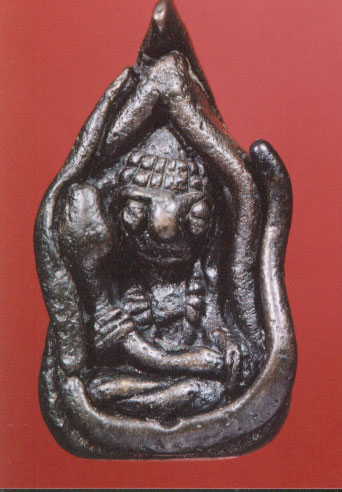This is a wonderful image from Burma of the Buddhist saint/spirit Upakhut (thanks very much to the photographer Ampika Rattanapitak). Here are two other images: upakhut-2.JPG and here upakhut-3.JPG.
Upakhut is an important figure in local belief in many areas of Burma, northern Thailand and Laos. The stories of his origins are numerous. (For those interested, The Legend and Cult of Upagupta by John Strong has a wealth of detail.) In Sanskrit legend he is the son of a perfume maker and one of the early followers of the Buddha. In northern Thailand, many villagers believe that Upakhut is the son of the Buddha himself. Legend has it that he was conceived when a fish ate some of the Buddha’s semen when he washed his robe (or bathed) in a river. Upakhut was born and lives in a grand palace at the bottom of the ocean. One of his key roles is to provide protection on the occasion of major Buddhist festivals (poi luang) when he is taken from the river and installed in a temporary pavilion in the temple grounds. Here is a brief description of one such occasion from the northern Thai village of Baan Tiam.
In northern Thailand it is customary to hold a great festival to consecrate and celebrate newly constructed or renovated Buddhist structures. In the village of Baan Tiam such a festival was held over five days in March 2004. In this case the poi luang was held to mark the renovation of the temple’s wiharn and chedi, the installation of new Buddha images and the renovation of the temple kitchen. It was an exceptional event.
After days of intense preparation the festival commenced on the nineteenth of March, late in the afternoon. A small procession wound its way out of the village, accompanied by drums, gongs and colourful flags. The purpose of the procession was to invite Phra Uppakhut to join the festival. Phra Uppakhut is locally believed to be the son of the Buddha who resides on the bottom of the main stream that winds its way through Baan Tiam’s paddy fields. On the outskirts of the village, the procession followed a narrow track down to the river where the village’s lay religious leader recited a prayer of invitation to Upakhut. He then reached into the river and drew out a small stone that was placed on the offering tray that he carried. Upakhut was a small dark and smooth pebble, about 3 centimetres high, rounded at the edges and having a shape vaguely reminiscent of a small Buddha image or amulet. During this brief ritual of invitation the procession was joined by two forest spirits with gruesome heads, toothy smiles and filthy robes. These spirits, phi koon, were also coming to join the festival–invited as representatives of the many spirits who had become aware of the poi luang due to its considerable fame. The procession then made its way back to the village, Upakhut silent on his tray and the spirits dancing around causing mayhem with young children and thrusting what appeared to be prominent erections beneath their robes in the direction of respectable village matrons. “This is just a small ritual” I was assured “it will be much more fun in the coming days.” When the procession reached the temple the spirits had no hesitation in entering, dancing their lurid way inside the compound, until their skins and heads were eventually shed and hidden away in a back room. Meanwhile Uppakhut was installed in a temporary pavilion (a “miniature wiharn”) at the back of the temple compound, next to the spirit house of the temple’s protective spirit. Uppakhut was provided with a monk’s robe, begging bowl, water bottle, pillow and fan. He was there to protect the festival. Food offerings were bought to him on the mornings that followed. [He was returned to the river on the final day of the festival.]
In northern Thailand many of the Upakhut amulets represent him in a rather different form to the Burmese style shown in the photos above. Here is an examlple:
In this type of amulet, Upakhut takes the form of a rather odd looking water spirit, often clutching a lotus flower and surrounded by fish and other aquatic creatures. Many amulets feature him cradled within a shell. I have been told many times that these types of amulets are of Khmer origin. If any New Mandala readers have any information on Khmer (or other) perspectives on Upakhut I would be very interested to hear the details!
 Facebook
Facebook  Twitter
Twitter  Soundcloud
Soundcloud  Youtube
Youtube  Rss
Rss 